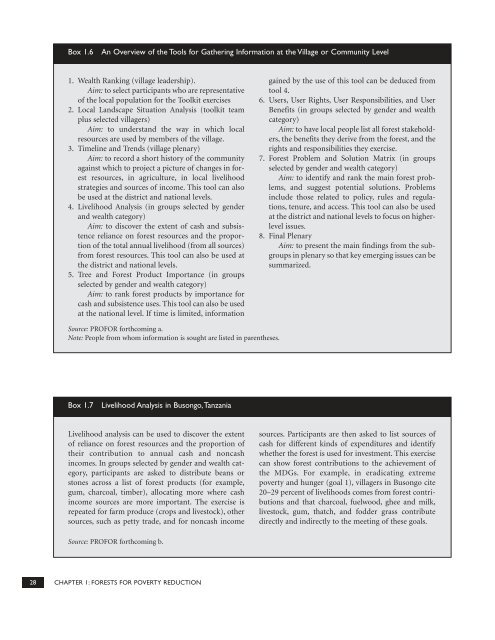Forests Sourcebook - HCV Resource Network
Forests Sourcebook - HCV Resource Network
Forests Sourcebook - HCV Resource Network
Create successful ePaper yourself
Turn your PDF publications into a flip-book with our unique Google optimized e-Paper software.
Box 1.6<br />
An Overview of the Tools for Gathering Information at the Village or Community Level<br />
1. Wealth Ranking (village leadership).<br />
Aim: to select participants who are representative<br />
of the local population for the Toolkit exercises<br />
2. Local Landscape Situation Analysis (toolkit team<br />
plus selected villagers)<br />
Aim: to understand the way in which local<br />
resources are used by members of the village.<br />
3. Timeline and Trends (village plenary)<br />
Aim: to record a short history of the community<br />
against which to project a picture of changes in forest<br />
resources, in agriculture, in local livelihood<br />
strategies and sources of income. This tool can also<br />
be used at the district and national levels.<br />
4. Livelihood Analysis (in groups selected by gender<br />
and wealth category)<br />
Aim: to discover the extent of cash and subsistence<br />
reliance on forest resources and the proportion<br />
of the total annual livelihood (from all sources)<br />
from forest resources. This tool can also be used at<br />
the district and national levels.<br />
5. Tree and Forest Product Importance (in groups<br />
selected by gender and wealth category)<br />
Aim: to rank forest products by importance for<br />
cash and subsistence uses. This tool can also be used<br />
at the national level. If time is limited, information<br />
gained by the use of this tool can be deduced from<br />
tool 4.<br />
6. Users, User Rights, User Responsibilities, and User<br />
Benefits (in groups selected by gender and wealth<br />
category)<br />
Aim: to have local people list all forest stakeholders,<br />
the benefits they derive from the forest, and the<br />
rights and responsibilities they exercise.<br />
7. Forest Problem and Solution Matrix (in groups<br />
selected by gender and wealth category)<br />
Aim: to identify and rank the main forest problems,<br />
and suggest potential solutions. Problems<br />
include those related to policy, rules and regulations,<br />
tenure, and access. This tool can also be used<br />
at the district and national levels to focus on higherlevel<br />
issues.<br />
8. Final Plenary<br />
Aim: to present the main findings from the subgroups<br />
in plenary so that key emerging issues can be<br />
summarized.<br />
Source: PROFOR forthcoming a.<br />
Note: People from whom information is sought are listed in parentheses.<br />
Box 1.7<br />
Livelihood Analysis in Busongo,Tanzania<br />
Livelihood analysis can be used to discover the extent<br />
of reliance on forest resources and the proportion of<br />
their contribution to annual cash and noncash<br />
incomes. In groups selected by gender and wealth category,<br />
participants are asked to distribute beans or<br />
stones across a list of forest products (for example,<br />
gum, charcoal, timber), allocating more where cash<br />
income sources are more important. The exercise is<br />
repeated for farm produce (crops and livestock), other<br />
sources, such as petty trade, and for noncash income<br />
sources. Participants are then asked to list sources of<br />
cash for different kinds of expenditures and identify<br />
whether the forest is used for investment. This exercise<br />
can show forest contributions to the achievement of<br />
the MDGs. For example, in eradicating extreme<br />
poverty and hunger (goal 1), villagers in Busongo cite<br />
20–29 percent of livelihoods comes from forest contributions<br />
and that charcoal, fuelwood, ghee and milk,<br />
livestock, gum, thatch, and fodder grass contribute<br />
directly and indirectly to the meeting of these goals.<br />
Source: PROFOR forthcoming b.<br />
28 CHAPTER 1: FORESTS FOR POVERTY REDUCTION

















